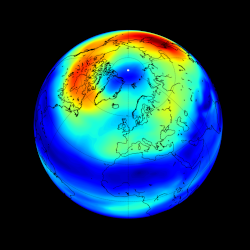A good news story
The Montreal Protocol, which entered into force in 1989, has successfully led to the phase-out of over 98 percent of the world’s emissions of ozone-depleting substances, resulting in a gradual recovery of the ozone layer.
“The Montreal Protocol has been enormously successful in controlling the atmospheric abundances of ozone-depleting substances and we are starting to see the slow recovery of the ozone layer, with associated climate benefits,” said Emeritus Professor John Pyle of this department. Pyle is one of four international co-chairs of the Montreal Protocol Scientific Assessment Panel, which prepares a report every four years on the depletion of the ozone layer and relevant atmospheric science issues.
“The Protocol has successfully linked science into policy and provides a template for future action to safeguard the environment,” he said.
New metric
Pyle and colleagues from this Department have proposed a new method to measure the impact of new emissions of illegal or unregulated ozone depleting substances on the ozone layer, which could make the treaty even more effective.
Up to now the ‘delay in ozone return data’ metric has been widely used to indicate the effect of different emissions or phase-down strategies, but the researchers argue it is ambiguous and of limited use.
Instead, the team have developed a new ‘integrated ozone depletion’ (IOD) metric, which takes into account the strength of new emissions and how long they persist in the atmosphere, in order to provide information about how the ozone layer might recover from specific emissions. It is simpler to calculate than previous metrics and less ambiguous.
Modelled total column ozone from the UKCA model (March 2011)
A tool for policymakers

The new metric, which has been published in Nature, is designed to provide a useful additional tool for policy makers and scientists to assess the impact of specific ozone depleting substances on ozone recovery.
“Typically we use complex models to make projections of stratospheric ozone recovery, but while these models are very useful they take a long time to run,” said co-author Dr James Keeble. “The IOD metric allows us to quickly estimate the impact of any unforeseen emissions of ozone depleting substances on ozone, and inform policymakers if any threats to ozone recovery emerge.”
The IOD metric will help scientists and policymakers safeguard the successes of the Montreal Protocol and protect the ozone layer. It will be included in the Scientific Assessment of Ozone Depletion, which is conducted under the auspices of the World Meteorological Organization and the United Nations Environment Programme and is published every four years.
The research was funded by the National Centre for Atmospheric Science, which supports fundamental research into atmospheric science. Pyle was awarded the 2018 Royal Society Davy Medal for his pioneering leadership in understanding the depletion of the global ozone layer and holds a CBE for services to atmospheric chemistry and environmental science.
Research
John A. Pyle, James Keeble, Nathan Luke Abraham, Martyn P. Chipperfield & Paul T. Griffiths, Integrated ozone depletion as a metric for ozone recovery, Nature 608, 719–723 (2022).

